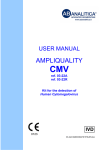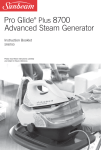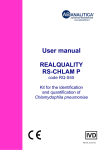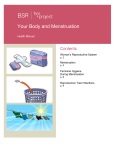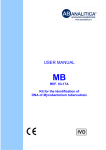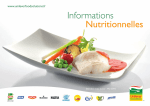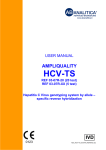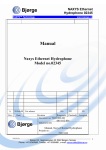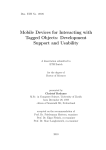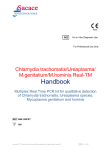Download CHLAM-T
Transcript
USER MANUAL Ampliquality CHLAM-T Code 03-10A Code 03-10R Kit for the detection of Chlamydia trachomatis 0123 03-10A-50(8033622781530)-EN.doc 1. PRODUCT INFORMATION ......................................................................................3 2. KIT CONTENTS........................................................................................................4 3. STORAGE AND STABILITY OF THE REAGENTS .................................................5 4. PRECAUTIONS FOR USE .......................................................................................6 5. SAFETY RULES.......................................................................................................7 5.1. General safety rules................................................................................................7 5.2. Safety rules about the kit .......................................................................................8 6. MATERIALS REQUIRED, BUT NOT PROVIDED....................................................9 6.1. Reagents..................................................................................................................9 6.2. Instruments .............................................................................................................9 6.3. Materials ..................................................................................................................9 7. PREPARATION OF THE REAGENTS ...................................................................10 8. INTRODUCTION.....................................................................................................11 9. TEST PRINCIPLE...................................................................................................12 10. PRODUCT DESCRIPTION.....................................................................................13 11. COLLECTION, MANIPULATION AND PRE-TREATMENT OF THE SAMPLES...14 12. PROTOCOL............................................................................................................15 12.1. DNA extraction...................................................................................................15 12.2. DNA amplification..............................................................................................15 12.2.1. TST DNA amplification 15 st 12.2.2. Direct amplification (1 amplification) of C. trachomatis DNA: 15 12.3. Visualization of the amplification products.....................................................16 12.3.1. Agarose gel electrophoresis 16 12.3.2. Sample Loading 17 12.4. Interpretation of results: TST DNA amplification and C. trachomatis first amplification.....................................................................................................................18 Page 1 03-10A-50(8033622781530)-EN.doc 12.5. 2nd C. trachomatis DNA amplification (nested PCR) ......................................19 12.6. Interpretation of results: 2nd amplification of Chlamydia trachomatis DNA.20 13. TROUBLESHOOTING............................................................................................21 14. DEVICE LIMITS ......................................................................................................23 15. DEVICE PERFORMANCES ...................................................................................23 15.1. Specificity ..........................................................................................................23 15.2. Sensitivity ..........................................................................................................23 16. 16.1. REFERENCES........................................................................................................24 Useful websites .................................................................................................24 Page 2 03-10A-50(8033622781530)-EN.doc 1. PRODUCT INFORMATION CHLAM-T: Kit for the detection of Chlamydia trachomatis by DNA amplification in the cryptic plasmid. The kit contains the reagents for DNA amplification and visualization by agarose gel electrophoresis, the internal control of sample amplificability, and positive control. Code 03-10A-25 03-10A-50 Product CHLAM-T CHLAM-T Pkg 25 tests 50 tests CHLAM-T - amplification reagents Kit for the detection of Chlamydia trachomatis by DNA amplification in the cryptic plasmid. The kit contains the reagents for DNA amplification, the internal control of sample amplifability, and the positive control. Code 03-10R-25 03-10R-50 Product CHLAM-T- amplification reagents CHLAM-T- amplification reagents Pkg 25 tests 50 tests Page 3 03-10A-50(8033622781530)-EN.doc 2. KIT CONTENTS Attention: the different contents correspond to different kits. (legend: X = component included in the kit; 0 = component not included in the kit) BOX P code 03-10A code 03-10R STORE AT – 20°C DESCRIPTION LABEL COLOUR OF TUBE (T) OR LID 25 tests 50 tests 8 tests X X Single dose premixes for CHLAM-T direct amplification Colourless (T) 25 50 8 X X Single dose premixes for CHLAM-T nested amplification Green (T) 25 50 8 X X Single dose premixes for TST (thiosulfate sulfurtransferase –rhodanese) amplification Blue (T) 25 50 8 X X Thermostable Taq DNA polymerase Red 1 x 50μL 1 x 100μL 1 x 20μL AB TAQ 5 U/μL SMALL BAG code 03-10A code 03-10R STORE AT – 20°C X X DESCRIPTION Plasmid DNA containing part of Chlamidia trachomatis genome LABEL CHLAM-T positive control COLOUR OF TUBE (T) OR LID 25 tests 50 tests 8 tests Blue 1 x 30 μL 1 x 50 μL 1 x 10 μL BOX F code 03-10A code 03-10R STORE AT +2°/ +8°C X 0 DESCRIPTION Loading Buffer for Electrophoresis X 0 Ethidium Bromide solution (2,5 mg/mL) X 0 DNA Molecular Weight Marker LABEL COLOUR OF TUBE (T) OR LID 25 tests 50 tests 8 tests 6X Blue Blue 1 X250μL 1 X450μL 1 X100μL Ethidium Bromide TOXIC R 23 68 S 36/37 45 Red 1 X170μL 1 X250μL 1 X100μL MW Marker Yellow 1 X200μL 1 X400μL 1 X70μL Page 4 03-10A-50(8033622781530)-EN.doc BOX A code 03-10A code 03-10R STORE AT +15°/ +25°C DESCRIPTION LABEL COLOUR OF TUBE (T) OR LID 25 tests 50 tests 8 tests X 0 Agarose for Molecular Biology AGAROSE 1X20g 1X40g 1X6g X 0 Electrophoresis buffer TRIS-Acetate-EDTA, pH 8,00 50X TAE 1X60mL 1X125mL 1X30mL 3. STORAGE AND STABILITY OF THE REAGENTS Each component of the kit must be stored according to the directions indicated on the label of the single boxes. In particular: Box P Small bag Box F Box A store at -20°C store at -20°C store at a +2°− +8°C store at +15°− +25°C When stored at the recommended temperature, all test reagents are stable until their expiration date. Page 5 03-10A-50(8033622781530)-EN.doc 4. PRECAUTIONS FOR USE • The kit must be handled by qualified investigators, who are educated and trained in molecular biology techniques applied to diagnostics; • Before starting the kit procedure, read carefully and completely the instruction manual; • Keep the product away from heat sources; • Do not use any part of the kit past the expiration date; • In case of any doubts or questions about the storage conditions or box integrity, contact AB ANALITICA’s technical support at: [email protected]; In the amplification of nucleic acids, the investigator has to take the following special precautions: • Use filter-tips; • Store the biological samples, the purified DNA, the reference DNA included in the kit, and all the amplification products in different places from where amplification reagents are stored; • Organize the work space into different pre- and post-PCR units; do not share instruments and consumables (pipettes, tips, tubes, etc.) between them; • Change gloves frequently; • Wash the bench surfaces with 5% sodium hypochloride; • The PCR premixes are thawed at room temperature before use; Add the Taq DNA polymerase and purified DNA very quickly at room temperature or in an ice-bath; Page 6 03-10A-50(8033622781530)-EN.doc 5. SAFETY RULES 5.1. General safety rules • Wear disposable gloves to handle the reagents and the clinical samples and wash your hands at the end of work; • Do not pipette with the mouth; • Since, no known diagnostic method can assure the absence of infective agents. It is a good rule to consider every clinical sample as potentially infectious and handle it as such; • All the devices that directly touch the clinical samples must be considered as contaminated and disposed as such. In case of accidental spilling of the samples, clean up with 10% Sodium Hypochloride. The materials used to clean up must be disposed of in special containers for contaminated products; • Clinical samples, materials, and contaminated products should be disposed of after decontamination by: immersion in a solution of 5% Sodium Hypochloride (1 volume of Sodium Hypochloride solution for every 10 volumes of contaminated fluid) for 30 min. OR autoclave at 121°C for at least 2 hours (NOTE: do not autoclave solutions containing Sodium Hypochloride!!) Page 7 03-10A-50(8033622781530)-EN.doc 5.2. Safety rules about the kit The risks for the use of this kit are related to the single components: Dangerous components: ETHIDIUM BROMIDE (included in the 03-10A kit) 3,8-diamino-1-ethyl-6-phenylphenantridiumbromide <2% Description of risk: T (Toxic) RISK SENTENCES AND S SENTENCES ETHIDIUM BROMIDE R 23 and R 68 S 36/37 45 Toxic for inhalation. Risk of irreversible effects. Wear laboratory coat and disposable gloves. In case of accident or discomfort, seek for medical assistance and show the package label. R and S sentences refer to the concentrated product, as provided in the kit. In particular for Ethidium Bromide, until it is diluted in the agarose gel. When handling concentrated Ethidium Bromide, use a chemical dispensing fume cabinet. Always wear disposable gloves and laboratory coat when handling diluted Ethidium Bromide solutions as well. The product must not be disposed of in the common waste. It must not go in the drain system. For disposal, follow local laws. In case of accidental spilling of Ethidium Bromide, clean with Sodium hypochloride and water. Material Safety data sheets of products are available upon request. Page 8 03-10A-50(8033622781530)-EN.doc 6. MATERIALS REQUIRED, BUT NOT PROVIDED 6.1. • • • • Reagents Reagents for DNA extraction; Sterile DNase and RNase free water; Distilled water; Reagents for DNA visualization by agarose gel electrophoresis (necessary for 03-10R kit). 6.2. Instruments • Laminar flow cabinet (use is recommended while adding TAQ polymerase to the amplification premix to avoid contamination; it would be recommended to use another laminar flow cabinet to add the extracted DNA); • Micropipettes (range: 0,2-2 µL; 0,5-10 µL; 2-20 µL); • Thermalcycler; • Microcentrifuge (max 12.000-14.000 rpm); • Balance; • Magnetic heating stirrer or microwave; • Chemical cabinet (use is recommended in handling Ethidium Bromide); • Horizontal electrophoresis chamber for agarose minigel; • Power supply (50-150 V); • UV Transilluminator; • Photo camera or image analyzer. 6.3. • • • • • Materials Disposable gloves; Disposable sterile filter-tips (range: 0,2-2 µL; 0,5-10 µL; 2-20 µL;); Graduated cylinders (1 L) for TAE dilution; Pyrex bottle or Becker for agarose gel preparation; Parafilm. Page 9 03-10A-50(8033622781530)-EN.doc 7. PREPARATION OF THE REAGENTS Preparation of 1 L of 1X TAE buffer: Mix 20 mL of 50X TAE (included in the 03-10A kit) with 980 mL of distilled water. Page 10 03-10A-50(8033622781530)-EN.doc 8. INTRODUCTION Chlamydia trachomatis is the ethyologic agent of several common sexually transmitted bacterial pathologies. Chlamydia genera encompasses low-dimension microorganisms, that reproduce exclusively in the cytoplasm of the host cell, in the vacuole. It is a bacterium with obliged endo-cellular parasitism (Fig. 1), due to its incapability to produce ATP and other necessary biosynthetic cofactors. Its morphogenetic cycle consists of two alternate cellular cycles: the elementary body and the reticular body. Fig. 1: Cytoplasmic inclusion of Chlamydia trachomatis The elementary body is the infective form and, for its survival capacity outside the eukaryotic cell, can be compared to a spore cell. Once it penetrates the eukaryotic cell, the elementary body develops after 10 hours from the infection. Then, the reticular body starts to reproduce up to cell death. Chlamydia trachomatis encloses 15 distinct serotypes: A,B,C serotypes are associated to trachoma (conjunctive infection); L1, L2, and L3 serotypes are associated to lymphogranuloma venereum; D to K serotypes are ubiquitous, generally associated to sexually-transmitted diseases; they infect the epithelial cells and cause infection in the pharynx, respiratory apparatus, urethra, and uterine tubes (also called Fallopian tubes). Each serotype has a plasmid (about ten copies per cell) that is believed to contain the essential genes for microorganism survival in the infected cell. Generally, C. trachomatis infection has a clinically latent form but can be the cause of ectopic pregnancy, female sterility, and male infertility. Newborns exposed to C. trachomatis infection can develop a conjunctivitis or an acute pneumonia that can lead to a chronic form. Most of the C. trachomatis infections are asymptomatic and it is generally difficult to distinguish an evident C. trachomatis infection from other sexuallytransmitted diseases; therefore it is important to have a quick, rapid, and reliable method for C. trachomatis detection. Recent studies suggest that there is a correlation between the exposure to different C. trachomatis serotypes and an increased risk of cervix cancer (Antilla et al. JAMA 2001). Page 11 03-10A-50(8033622781530)-EN.doc Even if HPV infection from oncogenic strains is the first cause of cervix cancer, the researchers are now focusing on C. trachomatis. It is not clear if this oncogenic risk is associated to specific microorganism’s serotypes (Koskela et al., 2000). Considering the high incidence (4%) of C. trachomatis infection in male donors, guidelines for the prevention of this pathogen’s transmission by artificial insemination have been recently proposed. The American Society for Reproductive Medicine and the European Society for Human Reproduction and Embryology affirm that tests for C. trachomatis identification should always be performed to screen urethral, urine, and seminal samples (American Society for Reproductive Medicine 1998, Baratt et al.,1998). 9. TEST PRINCIPLE PCR (Polymerase Chain Reaction) was the first method of DNA amplification described in literature. (Saiki RK et al., 1985). It can be defined as an in vitro amplification reaction of a specific part of DNA (target sequence) by a thermo-stable DNA polymerase. In the reaction, three segments of nucleic acid are involved: the double strand DNA template to be amplified (target DNA) and two single-strand oligonucleotides “primers” that anneal in a specific way to the template DNA. The DNA polymerase begins the synthesis process at the region marked by the primers and synthesizes new double stranded DNA molecules, identical to the original double stranded target DNA region, by facilitating the binding and joining of the complementary nucleotides that are free in solution (dNTPs). After several cycles, we can get millions of DNA molecules which correspond to the target sequence. The sensitivity of this test makes it particularly suitable to the application in laboratory diagnostic. Besides, the amplification reaction can be executed from a wide range of biological samples, and since PCR is able to amplify very small DNA segments, the starting DNA can also be partially degraded. Page 12 03-10A-50(8033622781530)-EN.doc 10. PRODUCT DESCRIPTION The method proposed in this kit consists of the amplification of the C. trachomatis cryptic plasmid DNA. The plasmid is highly conserved in all sierotypes of C. trachomatis, but absent in other species. The method can evaluate the suitability of extracted DNA, by amplification of TST (thiosulfate sulfurtransferase rhodanese) gene in the region 22q13.1 (amplification control). A negative result in the TST gene amplification indicates either the presence of inhibitors of the amplification reaction in the extracted DNA or that the DNA is highly degraded. This method helps the operator to recognize possible false negative results for C. trachomatis. The kit also provides a positive control for the amplification. When the amplification of the positive control is successful, this guarantees that the reaction worked correctly. The positive control is not dangerous for the operator, because it is plasmid DNA containing only a part of C. trachomatis cryptic plasmid. The kit is in premix format: all the reagents for the amplification are pre-mixed and aliquoted in single dose test-tubes, which Taq polymerase and the extracted DNA will be added to. This premix format reduces the manipulation steps in pre-amplification, saves considerable time for the operator, avoids repeated freezing/thawing of reagents (that could alter the product performances) and, above all, this format reduces significantly the risk of contamination and the risk of obtaining false positive results. For this reason, it is always recommended to use all the proper amplification controls. Page 13 03-10A-50(8033622781530)-EN.doc 11. COLLECTION, MANIPULATION AND PRETREATMENT OF THE SAMPLES The samples used in the laboratories for the determination of C. trachomatis infection, are cytological, like cell cultures, urethral swabs and cervix-vaginal swabs, sperm, urine, etc.. In the case of cervix and vaginal swabs, sample collection is performed by using a little swab or a little sterile brush (cyto-brush). The collected cells are diluted in a suitable transport media (1X PBS, physiological solution or other medium). The sample can be stored at +2 / +8°C for a max of 48 hrs.; after that, it is better to proceed with nucleic acid extraction. If it is not possible to extract the sample within a short period of time, the specimen must be stored at -20°C. When sample cellularity is too low, it could be necessary, before starting DNA extraction, to concentrate the sample by centrifuging repeatedly. For sample resuspension use sterile PBS, which can also be useful to remove mucus and red blood cells, if present. Seminal liquid is collected in a sterile container and stored at +4°C for some hours (maximum above night). Alternatively, it is frozen by adding a specific medium, which compatible with the DNA extraction method used in the molecular analysis. C. trachomatis detection from urine samples is usually performed from the first urination. It is necessary to discard the first part of urine flux and to collect only the second one in a sterile container. Page 14 03-10A-50(8033622781530)-EN.doc 12. PROTOCOL 12.1. DNA extraction Any extraction method can be used, provided that it extracts pure and integral C. trachomatis DNA. AB ANALITICA tested successfully methods based on spin columns (e.g. QIAmp DNA mini kit - QIAGEN) and methods based on matrixs (e.g. INstaGene Matrix – BIO-RAD). It is necessary to remember that the volumes of the extracted DNA, indicated in paragraph 12.2 for TST and C. trachomatis amplification, are referred to the extracts obtained with AB ANALTICA methods. When using an alternative extraction method, it will be necessary to adjust the volume of the amplification mix by adding water if the volume of the DNA solution for amplification is less than 20 μL. 12.2. DNA amplification 12.2.1. TST DNA amplification For each sample add to each premix tube (blue tube): 0,5 µL AB Taq 10 µL extracted DNA 12.2.2. Direct amplification (1st amplification) of C. trachomatis DNA: For each sample add to each premixed colourless tube: 0,5 µL AB Taq 10 µL extracted DNA Page 15 03-10A-50(8033622781530)-EN.doc It is important to include in each experiment a negative control (add 10 μL of distilled H2O instead of DNA to the mix) and a positive control (10 μL of the positive control included in the kit). Centrifuge briefly, put the tubes (TST and CHLAM-T) into the thermalcycler as programmed below: 1 cycle 30 cycles 1 cycle 95°C 5 min 95°C 45 sec 56°C 45 sec 72°C 45 sec 72°C 5 min Amplification products length: CHLAM-T: TST: 12.3. 594 bp. 202 bp. Visualization of the amplification products 12.3.1. Agarose gel electrophoresis Prepare a 3% agarose gel: Weight 1.5 g of agarose and pour it into 50 mL of 1x TAE. Leave the solution on a magnetic stirring heater or in a microwave, until the solution becomes clear. Allow the gel to cool for a few minutes and then add 10 µL of Ethidium Bromide solution. NOTICE: Ethidium Bromide is a strong mutagenic agent; always wear gloves and preferably work under a chemical safety cabinet during the handling of this reagent or gels containing it. Pour the gel into the appropriate gel casting tray, with the comb placed in and allow the gel to cool at room temperature or in a fridge until the gel becomes solid. Page 16 03-10A-50(8033622781530)-EN.doc When the gel is solidified, remove the comb carefully (pay attention not to damage the gel wells) and transfer the tray into the electrophoresis chamber. Pour the appropriate amount of 1x TAE buffer, so that it covers the gel completely (about 1-2 mm over the gel surface). 12.3.2. Sample Loading Mix in a tube or directly on a parafilm layer: 2 μL 10 μL of 6X Blue* of amplification product or DNA Molecular Weight Marker (MW*marker) Load the mixture in the gel wells; switch on the power supply and set the voltage between 80-100 V. Run the gel for about 40 min, then place the gel on an UV transilluminator and analyze the results by comparing the size of the amplification products with the reference Molecular Weight Marker. * = 6X Blue and PM Marker are included in 03-10A kit; for the use of another loading buffer or of another Molecular Weight Marker, follow the indications specified by the supplier. DNA Molecular Weight Marker (MW Marker, included in 03-10A kit) Fragment sizes: 501-489, 404, 331, 242, 190, 147, 111, 110, 67, 34x2, 26 bp. The 501-489 bp bands usually are not clearly distinguishable and appear as an unique band; the 26 and 34 bp bands are sometimes too small to be seen in a 3% agarose gel (because of their low molecular weight). NOTICE: UV rays are dangerous for skin and, above all, eyes: always wear gloves and safety glass or use the protection screen of the UV transilluminator. Page 17 03-10A-50(8033622781530)-EN.doc 12.4. Interpretation of results: TST DNA amplification and C. trachomatis first amplification The controls should show the following results: CONTROL RESULT INTERPRETATION Positive control POSITIVE The PCR amplification was performed correctly Negative control NEGATIVE Absence of contamination Then, for the interpretation of the band pattern, follow the table below: RESULT INTERPRETATION Absence of the TST gene band Sample not suitable for amplification (repeat the DNA extraction) Presence of the TST gene band Amplifiable sample Absence of Chlamydia trachomatis Proceed with the second band amplification to evaluate the real negativity of the sample Presence of the TST gene band Amplifiable and positive sample Presence of Chlamydia trachomatis for Chlamydia trachomatis band Page 18 03-10A-50(8033622781530)-EN.doc 12.5. 2nd C. trachomatis DNA amplification (nested PCR) Add to each premixed green tube, containing 48.5 μL of amplification mix: 0,5 µL AB Taq 1 µL First amplification product It is important to use in this step the negative and the positive controls included in the Chlamydia trachomatis direct amplification. When it seems useful, it is possible to include also a negative control for the nested amplification, by adding 1 µL of sterile water to the nested mix, instead of the direct amplification product. Centrifuge briefly, then put the tubes into the thermalcycler as programmed below: 1 cycle 35 cycles 1 cycle 95°C 5 min 94°C 45 sec 55°C 45 sec 72°C 45 sec 72°C 10 min Amplification fragment length: 201 bp. At the end of the amplification program, visualize the nested amplification products by a 3% agarose gel electrophoresis. Weight 1.5 g of agarose and pour it into 50 mL of 1X TAE. Follow the instructions indicated at paragraph 12.3. Page 19 03-10A-50(8033622781530)-EN.doc 12.6. Interpretation of results: 2nd amplification of Chlamydia trachomatis DNA The controls should show the following results: CONTROL RESULT Positive control POSITIVE Negative Control NEGATIVE Negative control of Nested amplification NEGATIVE INTERPRETATION The first and the second amplification was performed correctly Absence of contamination in the first amplification Absence of contamination in the second amplification Then, for the interpretation of the band pattern, follow the table below: RESULT INTERPRETATION Absence of Chlamydia trachomatis band in Negative sample for the first and second amplification Chlamydia trachomatis Presence of Chlamydia trachomatis band in Positive sample for the second amplification Chlamydia trachomatis Fig. 2: 3% agarose gel electrophoresis of the amplification products. 1. 2 – 4. 5 – 7. DNA Molecular Weight Marker. Direct PCR products. Nested PCR products. All samples are positive for C. trachomatis. Page 20 03-10A-50(8033622781530)-EN.doc 13. TROUBLESHOOTING No amplification products or positive control DNA band • TAQ polymerase was not correctly added to the premix - Use pipettes and tips with suitable volumes (pipette range 0,2 - 2 μL); Check visually that TAQ polymerase diffuse in the premix: this is easy because the enzyme is in dissolved glycerol that has a higher density; - Alternatively, check visually the drop of TAQ polymerase put on the tube wall, then centrifuge briefly. • The thermalcycler was not programmed correctly. - Check the conformity of the thermalcycler program and the temperature profile in the instruction manual. • The kit does not work properly - Store the premix, enzymes and reference DNA at -20°C; Avoid repeated freezing/thawing of the premix and the regents. No amplification bands for either TST or C. trachomatis in the tested sample, but a good band for the Positive controls • Problems during the extraction step - Be sure that the extraction kit is adequate and that you follow correctly all the instructions; - Consult the troubleshooting section of the extraction kit; - Repeat the DNA extraction starting from a new sample. The amplification was inhibited - Dilute the starting sample with distilled water and TE; Repeat the DNA extraction from a smaller amount of clinical sample; Use an adequate extraction system. Page 21 03-10A-50(8033622781530)-EN.doc Aspecific products or extrabands present after the visualization of the amplified product in agarose gel The thermalcycler makes temperature changes too slowly - Execute a thermalcycler revision. The preparation of the amplification reaction took too long time at room temperature. Accelerate the work time at room temperature; - Work on ice. • The extracted product was not purified - Use an extraction system, which purifies the sample well. The starting sample contained degraded DNA - Repeat the extraction step using another starting clinical sample; Be sure that the sample had been collected and stored in appropriate way. For any further problems contact AB ANALITICA’s technical support at: [email protected], fax (+39) 049-8709510, or tel. (+39) 049-761698. Page 22 03-10A-50(8033622781530)-EN.doc 14. DEVICE LIMITS The kit can have reduced performances if: • the clinical sample is not suitable for this analysis (incorrect transport media or incorrect sample storage); • the DNA is not amplifiable because of the presence of inhibitors of the amplification reaction or due to an inadequate extraction system; • the kit was not stored at the suggested temperature. 15. DEVICE PERFORMANCES 15.1. Specificity Primer sequence alignment in the most important databanks shows the absence of unspecific alignment and guarantees the amplification of C. trachomatis. Cross reaction with genomic DNA or other pathogenic microorganism nucleic acids have not been revealed. 15.2. Sensitivity It has been shown that a unique amplification step, using nested primers, has a detection limit of about 1 IFU (inclusion forming unit) after visualization by agarose gel electrophoresis. Each IFU contains about 10 cryptic plasmids. The addition of another amplification step increases the sensitivity by at least a factor of 10. Page 23 03-10A-50(8033622781530)-EN.doc 16. REFERENCES American Society for Reproductive Medicine. Fertil Steril 4(3), 1S-13S, 1998. Antilla T, Saikku P, Koskela P et al. JAMA 285(1), 47-51, 2001. Baratt C, Englert Y, Gottlieb C and Jouannet P. Hum Reprod 13(2), VII-IX, 1998. Koskela P, Antilla T, Bjorge T et al. Int J Cancer 85, 35-39, 2000. Saiki RK, Scharf S, Faloona F et al. Science 230, 1350-1354, 1985. 16.1. Useful websites http://www.drorlandella.it/chlamydia.htm Page 24 03-10A-50(8033622781530)-EN.doc AB ANALITICA srl Via Svizzera 16 - 35127 PADOVA, (ITALY) Tel +39 049 761698 - Fax +39 049 8709510 e-mail: info@abanalitica




























